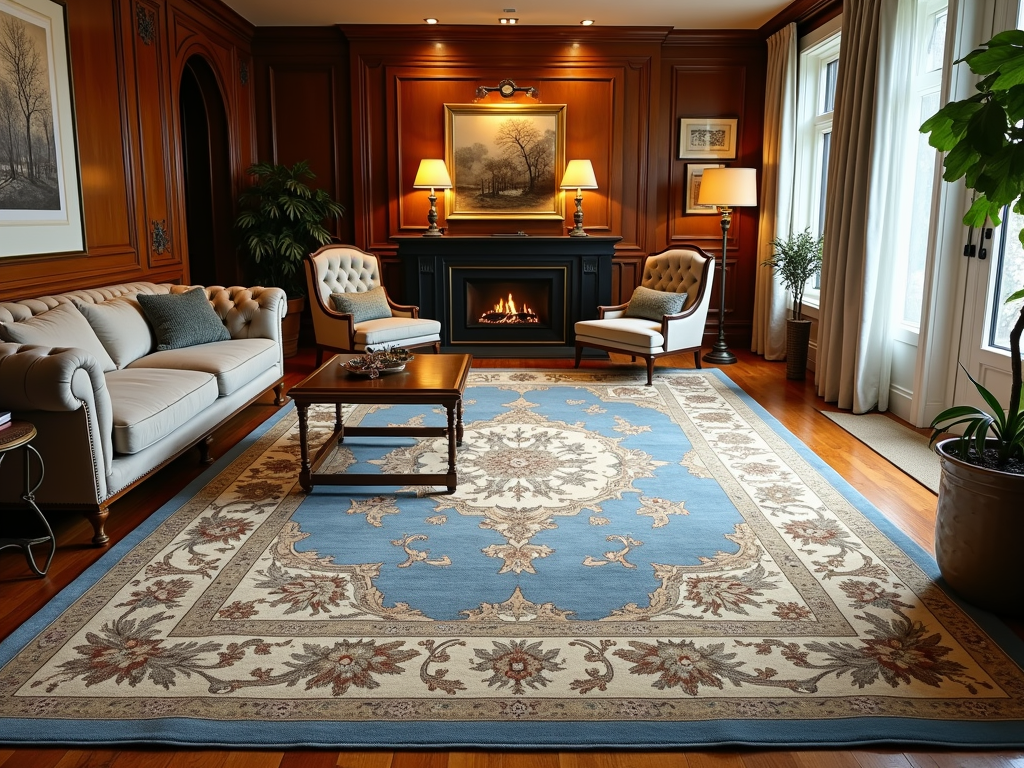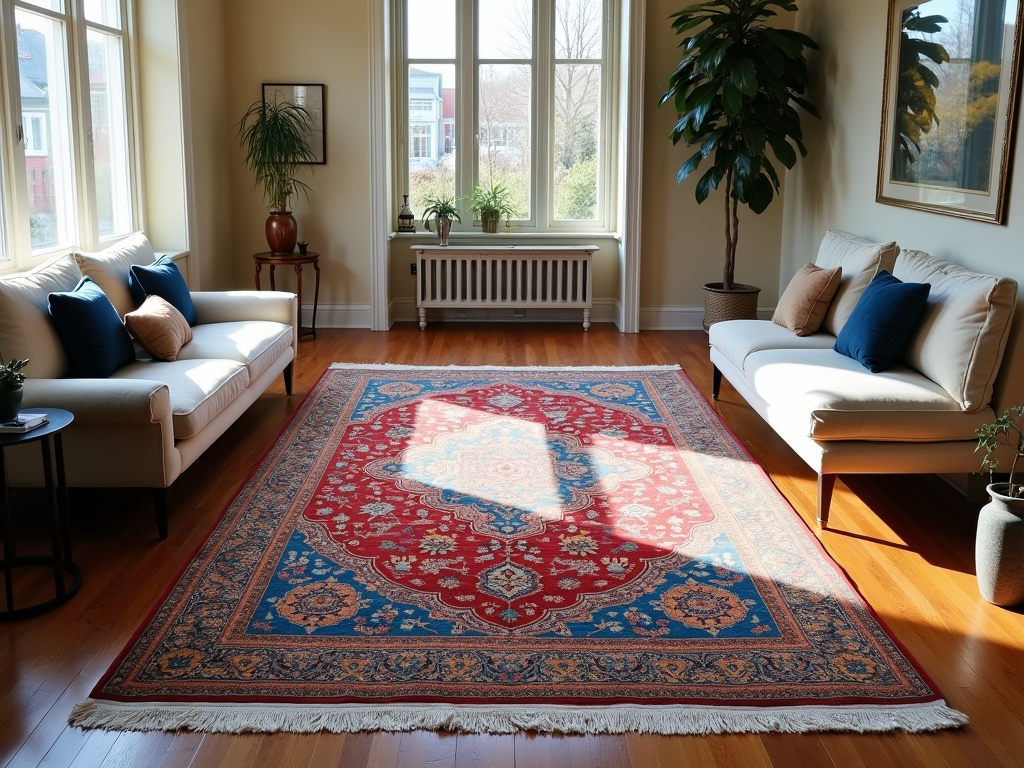
Area rugs and Persian rugs each have unique qualities that set them apart. While area rugs offer practical solutions for modern living, Persian rugs stand out as works of art imbued with cultural significance.
Key Takeaways
- Construction: Area rugs usually rely on machine production, offering consistency and efficiency. Persian rugs, however, are hand-knotted with remarkable skill, making each piece unique.
- Materials: Synthetic fibers, often used in area rugs, contribute to their affordability and versatility. Persian rugs, on the other hand, rely on natural materials such as wool or silk, adding a touch of elegance and authenticity.
- Durability: Area rugs tend to last 5-10 years, serving short-term needs effectively. Persian rugs, with good care, can remain in prime condition through multiple generations.
- Cost: Area rugs provide low-cost options, often starting at $50. Persian rugs, as investment pieces, range from several hundred to thousands of dollars, reflecting their craftsmanship and heritage.
- Purpose: Area rugs prioritize flexibility and cost-efficiency, fitting easily into everyday spaces. Persian rugs often carry the weight of tradition, doubling as decor and family treasures.
Area rugs serve as dynamic centerpieces in any room, helping to define spaces and anchor furniture. With their variety of shapes—rectangular, round, or square—and a broad spectrum of sizes, they can fit almost any design need. Materials like wool, synthetic fibers, cotton, jute, and even silk determine their feel and durability. Wool rugs add a layer of luxury, while synthetic options excel in affordability and stain resistance.
Popular Area Rug Styles
Styles like Shag, Dhurrie, and Kilim bring distinct personality. Shag rugs are perfect for cozy, relaxed spaces like bedrooms, while flatwoven Kilims add an artistic touch to living areas. For anyone looking for inspiration, explore the most popular styles of rugs to fit different aesthetics.
Tips for Choosing the Right Area Rug
To pick the right one, follow these simple steps:
- Measure your space carefully: Ensure your rug will complement the dimensions of the room.
- Choose appropriate furniture arrangement: A rug should extend under all key furniture for visual balance.
- Consider material and durability: Wool is luxurious and durable, while synthetic rugs are budget-friendly and stain-resistant.
By selecting the right area rug, you can achieve a harmonious blend of style and functionality in your space.
The Timeless Artistry of Persian Rugs
Persian rugs stand as true masterpieces, blending craftsmanship with cultural significance. Originating in Iran, they are hand-knotted with astonishing attention to detail. Each rug tells a story, woven into life through intricate patterns and exceptional materials like wool, silk, or cotton. What sets them apart is their knot density—the tighter the knots, the finer the detail. This labor-intensive process ensures that no two rugs are ever the same.
These rugs are deeply rooted in history, symbolizing status and tradition over centuries. Regional styles like Tabriz, Isfahan, and Nain introduce distinct personalities through their signature elements:
- Tabriz rugs often flaunt bold medallion patterns and rich blues.
- Isfahan pieces lean on delicate ivory tones and floral motifs.
- Nain rugs, crafted with creamy beige hues mixed with navy, exude elegance through their fine weaving.
When identifying an authentic Persian rug, consider its hallmarks:
- Quality hand-knotting
- Vibrant natural dyes
- Symmetrical fringe connected to the actual weave (not sewn on)
Knot counts per square inch reveal craftsmanship, with higher counts signaling superior quality. To maintain their timeless charm, avoid harsh chemicals during cleaning and rotate them periodically to prevent uneven wear.
For anyone passionate about home styling, understanding Persian rugs also means appreciating their artistic and functional contributions. These aren’t simply flooring solutions but unique creations that can redefine how you experience your space. To explore their broader impact, take a look at what you should know about area rugs.

Key Differences Between Area Rugs and Persian Rugs
Area rugs and Persian rugs stand apart in many ways, starting with how they’re made. Area rugs are typically machine-produced, focusing on versatility and cost-effectiveness, while Persian rugs are carefully hand-knotted, with each piece telling a unique story. The materials differ too—area rugs often use synthetic fibers like nylon or polyester, whereas Persian rugs are crafted from natural materials such as wool or silk, contributing to their durability and luxury.
Here’s a quick comparison to make it easier:
- Price Range: Area rugs usually start from $50 to a few hundred dollars. Persian rugs can range from $1,000 to tens of thousands.
- Durability: Machine-made rugs last 5-10 years. Hand-knotted Persian rugs often last generations.
- Purpose: Area rugs suit frequent updates or budget-conscious decorating. Persian rugs are timeless investments or cultural pieces.
For functional design themes, check out these stylish and functional area rugs.
Assessing Cost and Value: What to Expect
Cost is where the distinction between area rugs and Persian rugs really shines through. Area rugs are generally budget-friendly. You can get a small, machine-made option starting around $50. Handmade versions might stretch into the few hundred dollar zone, but they’re still accessible for most budgets. These rugs are perfect if you’re after a quick refresh or experimenting with décor styles without breaking the bank.
Persian rugs exist at a completely different price point. Depending on their size, age, materials, and the density of knots per square inch, they can cost anywhere from several hundred to several thousand dollars. Handmade Persian rugs use materials like wool or silk, and their complicated weaving techniques drive up the price. If you’re considering an older, antique piece, the value can climb significantly higher.
The cost differences boil down to craftsmanship and longevity. Area rugs are crafted for functionality and style but don’t usually have the lifespan of a Persian rug. On the other hand, Persian rugs are known for their durability, with quality pieces lasting decades or even generations. Many hold their value—or even appreciate—over time, making them a potential investment.
Whether you’re looking at the most budget-friendly area rugs or considering authentic Persian designs, understanding costs can help with decisions. For a closer look at styles and how they shape your room, you might explore some of the most popular styles of area rugs.
Choosing the ideal rug starts with understanding your needs, space, and personal taste. The way you use the room plays a big role, so think about a few key factors.
Deciding Between Area Rugs and Persian Rugs
First, consider your budget. Area rugs are often more affordable and come in various styles, making them a flexible option if you like experimenting with decor. Persian rugs, on the other hand, are typically an investment due to the craftsmanship and cultural significance they bring. If you’re drawn to timeless design with artistic value, Persian might be your go-to.
Room size and foot traffic are huge factors. Area rugs are practical for high-traffic areas like living rooms or hallways because they’re easier to clean and replace. For smaller, low-traffic spaces or areas you want to showcase, a Persian rug creates a stunning focal point.
Matching Rug Styles and Maintaining Their Beauty
For contemporary decor, I might choose an area rug with bold patterns or neutral colors—more inspiration on that can be found here. Persian rugs naturally pair with traditional or eclectic styles due to their intricate designs. Size-wise, make sure your rug complements the room—too small or too large can throw everything off.
For care, vacuum area rugs regularly and blot spills immediately. Persian rugs need gentler handling, like professional cleaning every 1-3 years and keeping them out of direct sunlight to prevent fading. Rotate them to spread wear evenly, which helps them last longer.
Sources:
The Spruce – Area Rugs vs. Oriental Rugs: What’s the Difference
RugKnots – The Complete Guide to Persian Rugs
The New York Times – Buying an Oriental Rug
Christie’s – Understanding Oriental Carpets
Good Housekeeping – How to Choose the Perfect Area Rug
